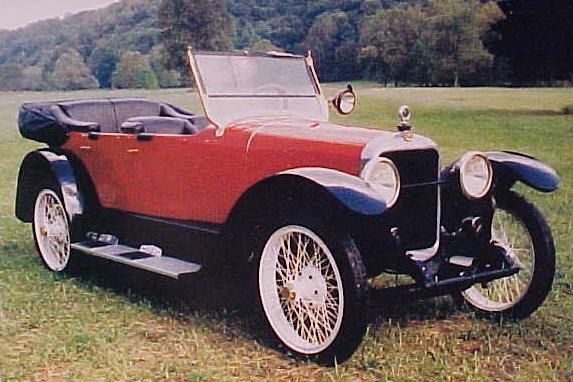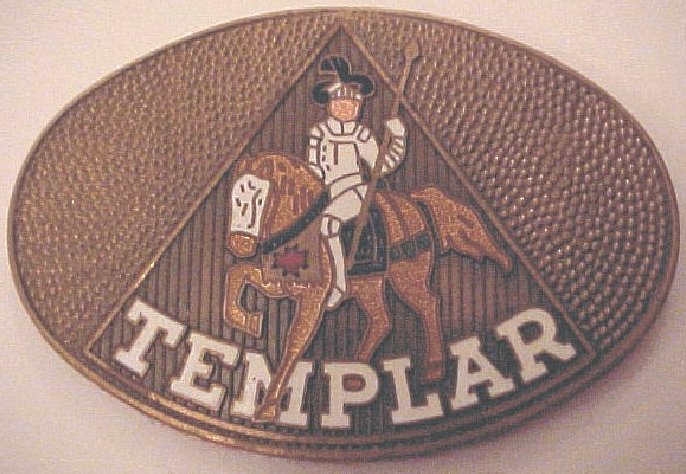Rare
1919 4-Door Templar Sportette

No
need to go on a crusade to discover the name of this mystery car!
"This car spent most of its life in Montgomery County, Kentucky,"
notes Merlin Spencer of Frenchburg, who restored the car for owner Ed Roberts
of Mt. Sterling. "There are fewer than 30 known to
survive." The car was built in Lakewood, Ohio for only 8
years. The name of the car suggests that it was named after the Order of
Knights Templar, as the Maltese Cross is also used as its emblem.

At
the time the Model T was selling for $500. - $700., this car was going for a
whopping $2,185. Some features the marquee had that others didn't
included an air compressor to pump up the tires, a sight gauge to check the
oil with the engine running, and a wooden body with an aluminum skin.
Some models came with a Kodak camera and a compass. The only feature
this curator sees missing is a white peacock feather roof that looks like a
chapeau! Ha! Ha!
A
special "Thanks" to Reminisce Extra, 5927 Memory Lane, Greendale, WI
53129. This car appears in their October, 2000 edition.

Templar was exemplar car
with Lakewood birthplace
It was the only automobile
built in Lakewood. A small, four-cylinder car made by Templar Motor Cars
from 1917 to 1924, it was manufactured on a 20-acre site south of Athens
Avenue to the former New York Central Railroad tracks, between Halstead and
Clarence avenues.
Templar Motors was formed by a
group of Cleveland investors in 1916, with production starting the following
year. Management took the name Templar from a military order founded in
Jerusalem by the crusaders about 1118. It chose the Maltese cross as the car's
emblem.
The corporation's main
building, a three-story brick, concrete and steel structure with 300,000
square feet of floor space, still stands at 13000 Athens Ave. It now houses 16
tenants, the largest of which is Lake Erie Screw Products Co.
Three of Templar's original
officers - President M. F. Bramley, Vice President W. J. Hunkin and Treasurer
D. C. Reed - were prominent in Lakewood community affairs.
Their factory complex cost $2.5
million, a whole lot of money then. Plant capacity was 5,000 cars a year,
though production was never in excess of a third of that. Actually, total
output during Templar's short span on the market was only 6,000 units.
Nevertheless, the automobile
that was advertised as "The Superfine Small Car" had a fair-sized sales
organization for its time. A 1920 company financial statement boasted of 106
dealerships and distribution centers in 32 states and 15 foreign countries.
The plant turned out 1,850 cars
that year, placing it sixth among Clevelend-area automakers and l5th in the
United States among manufacturers outside the Detroit area.
There were four models
initially - a sedan, a touring car and two sporty versions. At the outset they
cost from $1,985 to $2,255. The most eye-catching entry was a touring-roadster
introduced in 1921 and priced at $2,885.
The factory handled all final
assembly operations and made its own engine, a four-cylinder, overhead-valve
design that developed 43 horsepower and was considered more efficient than the
majority of American engines of the period. Most of the car's parts were
produced by supplier firms.
Lakewoodite Vernon Lieblein,
87, recalls working for Templar Motors as a teenager during the summers of
1917 and 1918, first as a service mechanic, later on the assembly line and
finally as a helper in the experimental department.
One of his last assignments was
to assist in building a special Templar for a famous race driver of the day,
E. G. "Cannonball" Baker, who had a promotional tie-in with the company.
Cannonball would challenge all
comers to match his Templar in speed, economy, endurance and reliability, and
he set numerous records.
"The car I worked on for him
was stripped down and fenderless, and had a top speed of 46 miles per hour, a
velocity that was nothing to sneeze at during that infant period in auto
history," Lieblein remembered.
"In 1919 he drove it from New
York City to Los Angeles in four and a half days - a remarkable feat,
considering the atrocious roads of the day. We even put a battleship steel
plate under the car to prevent engine damage while crossing rockstrewn
Arizona.
"Cannonball was a big hulk of a
man, 6 foot 6 and weighing 250 pounds," Lieblein said. "Just before he set
out, he told me he had slept for two whole days so that he would have the
energy to complete the run."
Newly built Templars were put
through their paces on a quarter-mile oval test track the company operated
adjacent to the west side of its main plant.
Cornelius Mahall, 75-year-old
proprietor of Mahall's Twenty Lanes in Lakewood, grew up near the Templar
factory and fondly remembers the test track.
"Watching through the fence, as
a 5-year-old kid, I was fascinated by the cars circling around," he recalled.
But all was not beer and
skittles for the fledgling car company.
In 1920 it began hurting badly
from the post-World War I depression, difficulty in obtaining parts and
growing competition from other carmakers. Henry Ford, for example, at times
sold his "Tin Lizzie" Model T for less than $300.
Then, on Dec. 13, 1921, a fire
broke out, and only the main fireproof building that remains today withstood
the blaze. Damage loss, estimated between $250,000 and $300,000, doesn't
appear particularly great by today's standards but was crippling 67 years ago.
Although Templar rebounded and
was producing at a rate of eight cars a day by April 1922, more problems
surfaced. Severe financial losses as well as stockholder controversies soon
beset the company.
Finally, in the fall of 1924,
Templar defaulted on payment of a substantial loan and was taken over by a
Cleveland bank.
Production halted and failure
of the company caused about 20,000 investors to lose a total of $6 million, a
sum that today, with the effects of inflation, would amount to more than $42
million.

